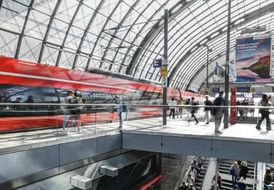Development in the year under review
- Noticeable recovery in demand after Covid-19 restrictions leads to a significantly positive reduction in revenues.
- Punctuality greatly affected by rising volume produced and construction-related capacity restrictions in the infrastructure; as a result, customer satisfaction was also under significant pressure.
- Continued high capital expenditures in the vehicle fleet.
DB Long-Distance | 2022 | 2021 | Change | 2019 | |
absolute | % | ||||
Punctuality (rail) (%) | 65.2 | 75.2 | –10.0 | – | 75.9 |
Customer satisfaction (SI) | 74.8 | 77.8 | –3.0 | – | 76.5 |
BahnCards (thousand) | 5,107 | 4,558 | +549 | +12.0 | 5,292 |
Passengers (rail) (million) | 132.0 | 81.9 | +50.1 | +61.2 | 150.7 |
Volume sold (rail) (million pkm) | 41,720 | 24,762 | +16,958 | +68.5 | 44,151 |
Volume produced (million train-path km) | 158.9 | 144.4 | +14.5 | +10.0 | 145.7 |
Load factor (%) | 45.9 | 31.4 | +14.5 | – | 56.1 |
Total revenues (€ million) | 4,980 | 2,911 | +2,069 | +71.1 | 4,985 |
External revenues (€ million) | 4,845 | 2,792 | +2,053 | +73.5 | 4,824 |
EBITDA adjusted (€ million) | 389 | –1,434 | +1,823 | – | 789 |
EBIT adjusted (€ million) | –39 | –1,790 | +1,751 | –97.8 | 485 |
Gross capital expenditures (€ million) | 1,667 | 1,507 | +160 | +10.6 | 1,241 |
Employees as of Dec 31 (FTE) | 19,139 | 18,790 | +349 | +1.9 | 17,289 |
Annual average employees (FTE) | 18,931 | 18,961 | –30 | –0.2 | 17,036 |
Employee satisfaction (SI) | 3.6 | – | – | – | ‒ |
Share of women as of Dec 31 (%) | 26.7 | 26.9 | –0.2 | – | 27.2 |
Specific final energy consumption compared to 2006 (based on pkm) (%) | –23.1 | +16.8 | –39.9 | – | –31.5 |
The punctuality of DB Long-Distance declined significantly in 2022. The primary causes of this were capacity restrictions due to construction work (including on the Riedbahn) while at the same time increasing volume produced and increasing infrastructure disruptions as a result of outdated and fault-prone facilities (including damaged concrete ties). In addition, disruptions on the busy rail connections led to disproportionately high congestion that had an impact on the entire rail network. In addition, the series of storms in February, a large number of hot days between June and August, the line closure due to the goods supply in Gifhorn in November and other external individual events had a negative impact on punctuality. In addition, the very high sick leave at times had an impact on the operating quality. On the other hand, increased ICE vehicle availability and the reduction of train cancellations had a positive effect.
In order to assess customer satisfaction, about 11,000 customers were asked how satisfied they were with their current journey in six waves on board the trains in 2022. Customer satisfaction fell in 2022 due to the general operating environment. Punctuality deteriorated significantly, particularly in the middle of the year. In addition, the sharp rise in the number of passengers had an impact on capacity utilization and customer satisfaction.
After Covid-19-related declines, the number of BahnCards rose again. This affected all types of BahnCard.
The positive trend continued in 2022, performance development recovered significantly and has largely reached pre-Covid-19 levels since April 2022:
- Number of passengers and volume sold: Above all, the suspension of the majority of measures to contain the Covid-19 pandemic led to a significant increase, particularly among private customers.
- Volume produced: Positive effects from fewer Covid-19 restrictions and the expansion of available offers outweighed the negative effects from construction activities on the network.
- Load factor: Marked improvement again as a result of the increased number of passengers.
Economic development improved significantly, but remains challenging overall. Operating profit figures improved significantly, driven by a disproportionate increase in income compared to expenses. Income rose sharply:
- Revenues: The recovery in demand led to a very significant rise in revenues.
- Other operating income: Also a significant increase (+71.6%/€ +192 million), primarily as a result of the train-path price reimbursements by the Federal Government for the partial compensation of losses in connection with the Covid-19 pandemic (in the previous year, these were included in full in the extraordinary result). This was counteracted by lower income from vehicle sales, among other things.
Expenses increased noticeably, primarily as a result of the significant increase in volume sold and volume produced, as well as price increases:
- Cost of materials: The increase (+8.8%/€ +246 million) was mainly due to higher volume-related infrastructure and energy expenses. In addition, price effects had a negative impact on infrastructure expenses. Additional cost increases resulted from higher revenue-related use of goods in on-board catering, increased expenses for distribution services, vehicle cleaning and the recovery in cross-border transport services. The weak operating quality and higher number of passengers also led to additional expenses in the area of customer service.
- Other operating expenses: The increase (+20.1%/€ +123 million) resulted among other things from increased rental expenses in connection with cross-border transport (resumption after Covid-19-related restrictions). In addition, more intensive advertising activities to regain customers, the implementation of IT projects, digitalization measures and positive performance development increased expenses.
- Depreciation: The increase (+20.2%/€ +72 million) was primarily due to the addition of ICE 4 trains and the redesign of ICE 1 and ICE 3 trains. Partially counteracting effects resulted from ICE 2 and Intercity 1 trains reaching the end of their useful lives.
- Personnel expenses: The development (+5.4%/€ +65 million) resulted mainly from the collective bargaining agreements and from allocations to provisions, primarily for overtime.
Capital expenditure activities rose from a very high level, resulting primarily from continued vehicle projects.
The number of employees increased as of December 31, 2022, primarily for performance-related reasons.
Employee satisfaction has fallen compared with 2020. The operational challenges had an impact on satisfaction, in particular in professions that are strongly influenced by operations.
The proportion of women remained virtually unchanged.
In 2022, the change in the specific final energy consumption on rail has fallen compared with 2006 (based on passenger kilometers). This improvement resulted from a further increase in the load factor and significantly higher energy efficiency due to the continuous conversion of the long-distance transport fleet to new and more energy-efficient series, such as the ICE 4. In addition, energy consumption was reduced using the driving assistance system and the driving recommendations tailored to energy-efficient train runs, and the three-phase converters were changed in the 40 ICE 1 stock. In addition, the drivers received extensive training on energy-efficient driving, and a higher energy recovery rate was achieved for the 147 series by adapting the regulations.


